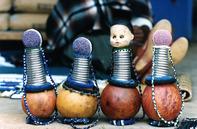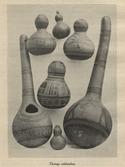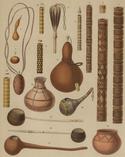
Gourds come in a wide variety of shapes and sizes. Some are globular, while others are flask-like. Many have long necks, whereas others have double bowls. To this day, they are used, not only to make various household artefacts, but also to fashion toys, pipes, snuff containers and musical instruments. In the past, small gourds commonly served as medical vials, and among communities in the Eastern Cape large ones are known to have been used as basins to wash new-born babies. Some of these were destroyed once the mother and her child came out of seclusion, but in other cases they continued to serve as ritual containers, for example, in the washing of twins periodically as they grew up.

The practice of decorating gourds was widespread. Various techniques were used for this purpose, including engraving, branding, and covering the gourd with beadwork or brass and copper wire. Among Zulu-speaking communities, a beaded fringe was often added to the necks of water calabashes. Some gourds were also stitched with thread, when broken. Popular as souvenirs, especially in the early 20th century, some were richly decorated for sale to colonial officials and European visitors pioneering the emerging tourist market for newly-established game lodges.

In contrast to gourds used as ladles, or to store and transport water and other liquids on a daily basis, extensively beaded examples were probably never produced as utensils. A beaded gourd documented by Muller and Snelleman in the 1890s which they labelled as ‘Zambeze’ was encased in intricately fashioned zigzag patterns sewn from six or seven different bead colours. The decorative effect was reinforced by the addition of a beadwork tassle.